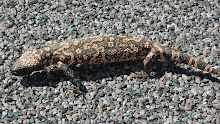 Photos show a flower of Lobivia huascha rubra from a slight distance and then two close-ups of bees visiting the flowers.
Photos show a flower of Lobivia huascha rubra from a slight distance and then two close-ups of bees visiting the flowers.
 Late in May, one of the loveliest of our landscaping cacti burst into bloom. This cactus, native to Bolivia, is Lobivia huascha rubra. Its brilliant flowers are mostly red, but various clones or varieties show colors ranging from orange-red to blue-red. There is also iridescence on the petals to some extent. In the clone I have growing in my yard, the petals are overlaid with a violet tinge that shimmers in the sun, changing as you view it from different angles.
Late in May, one of the loveliest of our landscaping cacti burst into bloom. This cactus, native to Bolivia, is Lobivia huascha rubra. Its brilliant flowers are mostly red, but various clones or varieties show colors ranging from orange-red to blue-red. There is also iridescence on the petals to some extent. In the clone I have growing in my yard, the petals are overlaid with a violet tinge that shimmers in the sun, changing as you view it from different angles.Not only does a single flower have great beauty, but the plant bursts into bloom bearing multiple flowers per stem, and a given plant can have many stems. The largest plant I have displayed over 70 blossoms open on May 31. The blooms only last one day, but then there are repeat, smaller blooms later in the season. This plant has been used widely in hybridizing between Lobivia and Echinopsis (now including Trichocereus as well) to introduce red coloration into flowers.
I remembered from my days at the Arboretum that when our Lobivia huascha rubra plants were blooming, plants were also in bloom on the same day all over the state. I found this out by calling other botanical gardens and asking. So, I drove around our neighborhood here in Queen Valley, and sure enough, everyone who had this plant in their landscaping had many flowers open on May 31 as well. There were some truly stunning displays. It's too bad that so many of the people here are snowbirds, roosting in cooler summer climates; they missed this event.
The native bees had a field day visiting the flowers. They zoomed in and out of the flowers, intent on harvesting pollen and nectar. These are very handsome, gray plush ground-nesting bees. They often remained deep in the flower for some minutes before emerging to fly to another blossom. Their presence could be detected by the wiggling stamens as the bee moved around their bases.























